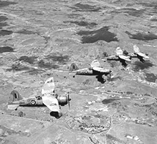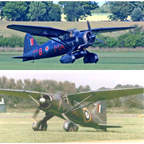August, 1962

Westland "Lysander"
Model Airplane News Cover Art for August, 1962
by Jo Kotula
Click to Enlarge
The Westland Lysander was a World War II British army liaison aircraft produced by Westland Aircraft. It was renowned for its ability to operate from small, unprepared airstrips that made possible clandestine missions behind enemy lines to place or recovere agents. It was most often used in occupied France. it was given the name of the Spartan general Lysander who led a heroic stand with a small band of men.


Westland "Lysander"
Click to Enlarge
The 1934 Westland design, internally designated P.8, was the work of Arthur Davenport under the direction of W.E.W. (Teddy) Petter. It was Petter's second aircraft design and he spent considerable time interviewing Royal Air Force pilots to find out what they wanted from such an aircraft. The result of Petter's enquiries suggested that field of view, low-speed handling characteristics and STOL performance were the most important requirements. Davenport and Petter worked to design an aircraft around these features: the result was unconventional It had high wings and a fixed conventional landing gear faired inside large, streamlined spats. The spats had mountings for small, removable stub wings that could be used to carry light bombs or supply canisters. In appearance it was not dissimilar to the Polish LWS-3 Mewa. The wings had an unusual reverse taper towards the root, which gave the impression of a gull wing, although in fact the spars were perfectly straight. It had a girder type construction with an light wood frame around that to give the aerodynamic shape. The forward part was duralinum tube joined with brackets and plates, the after portion stainless steel tubes welded. Plates and brackets were cut from channel extrusions rather than forming from sheet steel. The front spar and lift struts were extrusions. The wing itself was fabric covered.

The "Lysander"
in Popular Mechanics February, 1937
Click to Enlarge
The first Lysanders entered service in June 1938, were initially used for message-dropping and artillery spotting. When war broke out in Europe, the earlier models operated with the Chindits of the British Indian Army in the Burma Campaign. Four regular squadrons equipped with Lysanders accompanied the British Expeditionary Force to France. These were put into action as spotters and light bombers. In spite of occasional victories against German aircraft, they made very easy targets for the Luftwaffe unless escorted by Hurricanes. Almost half the Lysanders operating in and over France were lost and, with the fall of France, the type was quickly withdrawn from its army co-operation role. Back in England, some went to work operating air-sea rescue dropping dinghies to downed RAF aircrew in the English Channel.
In August 1941, a new squadron, No. 138 (Special Duties), was formed to undertake missions for the Special Operations Executive to maintain clandestine contact with the French Resistance. Among its aircraft were Lysander Mk IIIs, which would fly over and land in occupied France. While general supply drops could be left to the rest of No. 138's aircraft, the Lysander could insert and remove agents from the continent or retrieve Allied aircrew who had been shot down over occupied territory and had evaded capture. For this role, the Mk IIIs were fitted with a fixed entry/exit ladder over the port side to hasten access to the rear cockpit and a large drop tank under the belly. In order to slip in unobtrusively, the Lysanders were painted matte black; operations almost always took place within a week of a full moon, as moonlight was essential for navigation.
The Lysanders flew from secret airfields at Newmarket and later Tempsford, but used regular RAF stations to fuel-up for the actual crossing. Flying without any navigation equipment other than a map and compass, Lysanders would land on short strips of land, such as fields, marked out by four or five torches. They were only designed to carry one passenger in the rear cockpit, but in case of urgent necessity, three could be carried in extreme discomfort. The pilots of No. 138 and, from early 1942, No. 161 Squadron transported 101 agents to, and recovered 128 agents from Nazi occupied Europe. The Lysander proved to be a success in this role and continued to undertake such duties until the liberation of France in 1944.
Here is a video of the Westland "Lysander":
Click Here for more information about the Westland "Lysander".

Click to go back and select another cover.
Counter for the Entire Site (not just this page..)
Home | About Lindy | Last Week's Reviews | Upcoming Events | 1940s Collecibles
The Guide - Establishments - Travel - Accessories
Music | Links | Photo Gallery | Extras | Contact